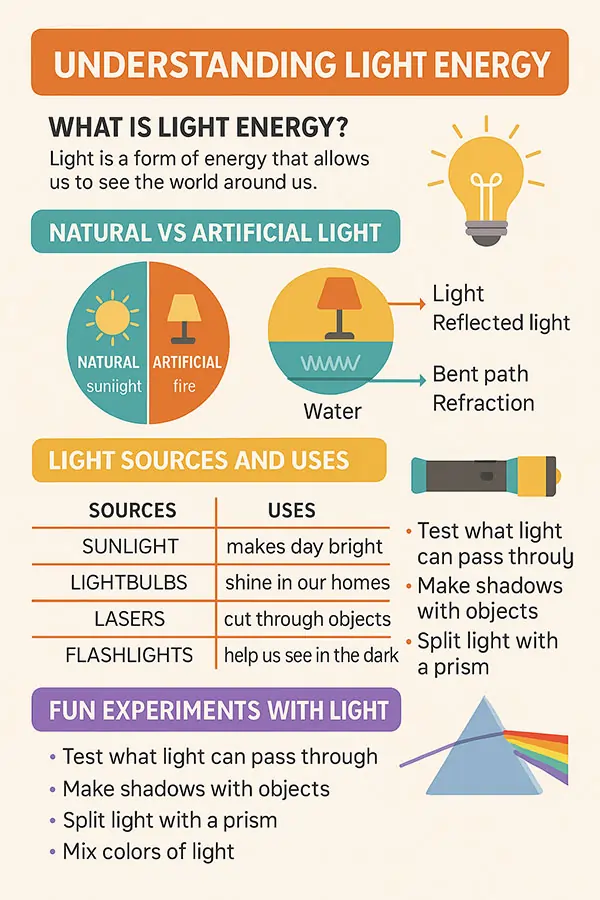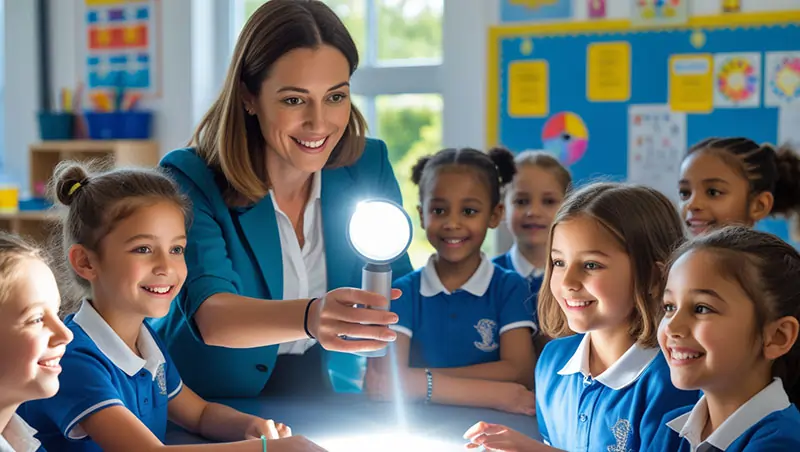Understanding Light Energy: A Kid-Friendly Science Guide
There is light all around us! Light is a big part of our lives every day, from the sun shining in the sky to the lamp on your desk. This guide for kids will explain what light energy is, how it works, and why it’s so important. Get ready to discover the science of light for kids!
1. What is Light Energy?
Light energy is a type of energy, so we can see it. It travels in waves and moves very quickly, faster than anything else in the universe. Light energy helps us see, stay warm, and even helps plants grow.
Key Points:
- Light is a kind of electromagnetic energy.
- It travels in straight lines.
- It can go through space without any air.
Fun Fact: Light moves at a speed of about 300,000 kilometers per second.
2. Natural vs Artificial Light
There are two main types of light sources:
Light from nature: This comes from the outside world. The sun is the main source. Other natural sources include stars, lightning, and fireflies.
Artificial Light: This kind of light is made by people. Some examples are LED lights, flashlights, and light bulbs.

Chart: As you can see above, we mostly need natural light during the day and artificial light at night.
3. Reflection and Refraction
Light acts in strange ways when it hits things.
Reflection: Reflection is what happens when light hits a surface, like a mirror, and bounces off. That’s how you can see yourself in a mirror!
Refraction: Refraction is when light bends as it passes through something clear, like glass or water. This bending is called refraction.
Try This: Put a pencil in a cup of water. Doesn’t it look like it’s bent? That’s what it means to refract!
4. Light Sources and Uses
| Light Source | Type | Common Use |
| Sun | Natural | Daylight, plant growth |
| Light bulb | Artificial | Room lighting |
| Candle | Artificial | Light during power cuts |
| Firefly | Natural | Nature’s flashlight! |
| Flashlight | Artificial | Emergency and camping light |
Light is used for:
- Seeing things clearly
- Reading and writing
- Growing plants (photosynthesis)
- Helping doctors (X-rays, lasers)
- Entertainment (TV, movies)
5. Fun Experiments with Light
A. Shadow Play:
- You will need a white wall, a flashlight, and some toys.
- How to: Shine the flashlight on the toy and look at the shadow on the wall. Move the flashlight closer and farther away to see how the shadow changes.
B. Rainbow in a Glass:
- You need a mirror, a flashlight, and a dark room.
- How to: Place the mirror in the water at a slant. Put the flashlight in front of the mirror. A tiny rainbow!
C. Ink that you can’t see:
- You will need lemon juice, a cotton bud, white paper, and a lamp.
- How to: Write with lemon juice. Give it time to dry. Put it near the light. The message appears with light!
6. Worksheet-Based Activities
These activities will help you remember what you learned.
Find the Pairs:
- Sun—Natural
- Bulb—made by people
- Mirror—reflection
- Water—Bending
Fill in the blanks:
1. ________ lines are the paths that light takes.
2. ________ is the word for how light bends.
3. The sun gives off ________ light.
4. We use a ________ to see in the dark.
Add a label to the picture: Draw a mirror, a ray of light that hits it, and a ray of light that bounces off of it. Label the parts.
Download Printable Worksheet ?
7. Quiz and Review
Multiple Choice Questions:
- What is the main source of natural light?
a) A flashlight
b) The sun
c) A light bulb - What happens to light when it hits a mirror?
a) Refraction
b) It goes away
c) Reflection - Which of these is NOT a source of artificial light?
a) Firefly
b) Bulb
c) Tube light
True or False:
- Sound moves faster than light. (False)
- Mirrors don’t use refraction to make pictures. (False)
- Plants need light energy to grow. (True)
8. Frequently Asked Questions (FAQ)
Q1: Can we see light?
Yes, we can see light when it hits our eyes and bounces off things.
Q2: Why is the sky blue?
When sunlight hits air particles and spreads blue light more, this is called scattering.
Q3: Is fire a source of light energy?
Yes, fire produces both heat and light energy.
Q4: Why do fireflies and glowworms shine?
They use chemicals in their bodies to make light. This is what bioluminescence is.
9. Related Science Topics
Want to learn more? Check out these other topics:
- Heat Energy: How energy makes things warm
- Sound Energy: How vibrations make sound
- Electricity: How the light bulb gets power
- The Solar System: How the sun lights our world
- Colors of Light: How white light changes into a rainbow
Conclusion
It’s fun and interesting to learn about light energy. Light is really cool. It can brighten our lives, help plants grow, and help doctors get better. With the science of light for kids, you can see the world in a whole new way! Keep exploring and trying new things. And don’t forget that you use light energy every time you turn on a light or feel the sun on your face!

